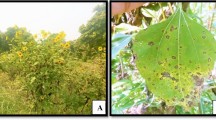Abstract
Severe brown spots caused by Cladosporium herbarum appeared on the leaves of Hyoscyamus muticus (Egyptian henbane) grown in a greenhouse at Yamaguchi city, Japan, in the summer of 2008. Nucleotide sequence analysis of rDNA-ITS and 28S rDNA supported the morphological identification of the isolate, which caused the same disease symptoms after reinoculation of the host. This new disease was named “Cladosporium leaf spot of Egyptian henbane”.

Similar content being viewed by others
References
Berner DK, Smallwood EL, McMahon MB, Luster DG (2007) First report of leaf spot caused by Cladosporium herbarum on Centaurea solstitialis in Greece. Plant Dis 91:463
El Naggar SM, Abdel-Hafez SII (2003) Leaf surface, pollen morphology, fungal biodiversity and leaf spots of some wild plants in Sinai, Egypt. Feddes Repert 114:74–90
Johnson DA, Pimentel G, Dugan FM (2008) Cladosporium herbarum causes a leaf spot on Caltha leptosepala (marsh marigold) in Western North America. Online Plant Health Prog. doi:10.1094/PHP-2008-1121-01-RS
Kwon JH, Kang SW, Kim JS, Park CS (2001) Scab of tea (Thea sinensis) caused by Cladosporium herbarum in Korea. Plant Pathol J 17:350–353
Moubasher AH (1993) Soil fungi in Qatar and other Arab countries. Scientific and Applied Research Center, University of Qatar, Doha
Oksman-Caldentey KM, Vuorela H, Isenegger M, Strauss A, Hiltunen R (1987) Selection for high tropane alkaloid content in Hyoscysamus muticus plants. Plant Breed 99:318–326
Ouchi S, Hatamoto M, Oku H, Shiraishi T, Yokoyama T, Tateishi M, Fujii S (1976) Brown spot of grapes caused by Cladosporium cladosporioides and Cladosporium herbarum. Sci Rep Fac Agr Okayama Univ 48:17–22
Perelló AE, Sisterna MN, Moreno MV (2003) Occurrence of Cladosporium herbarum on wheat leaves (Triticum aestivum) in Argentina. Australas Plant Pathol 32:327–328
Phytopathological Society of Japan (2000) Common names of plant diseases in Japan. Plant Protection Association, Tokyo, Japan
Schubert K, Groenewald JZ, Braun U, Dijksterhuis J, Starink M, Hill CF, Zalar P, de Hoog GS, Crous PW (2007) Biodiversity in the Cladosporium herbarum complex (Davidiellaceae, Capnodiales), with standardisation of methods for Cladosporium taxonomy and diagnostics. Stud Mycol 58:105–156
White TJ, Bruns T, Lee S, Taylor J (1990) Amplification and direct sequencing of fungal ribosomal RNA genes for phylogenetics. In: Innis MA, Gelfand DH, Sninsky JJ, White TJ (eds) PCR protocols: a guide to methods and applications. Academic Press, San Diego, pp 315–322
Acknowledgments
The authors thank the Department of Missions (Ministry of Higher Education and Scientific Research, Egypt) for providing financial support through a channel system scholarship to F. F. Abdel-Motaal.
Author information
Authors and Affiliations
Corresponding author
Rights and permissions
About this article
Cite this article
Abdel-Motaal, F.F., El-Sayed, M.A., El-Zayat, S.A. et al. Leaf spot disease of Hyoscyamus muticus (Egyptian henbane) caused by Cladosporium herbarum . J Gen Plant Pathol 75, 437–439 (2009). https://doi.org/10.1007/s10327-009-0200-2
Received:
Accepted:
Published:
Issue Date:
DOI: https://doi.org/10.1007/s10327-009-0200-2




